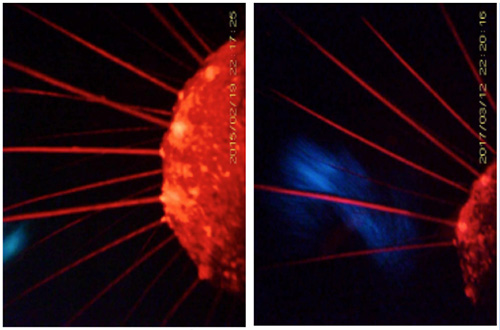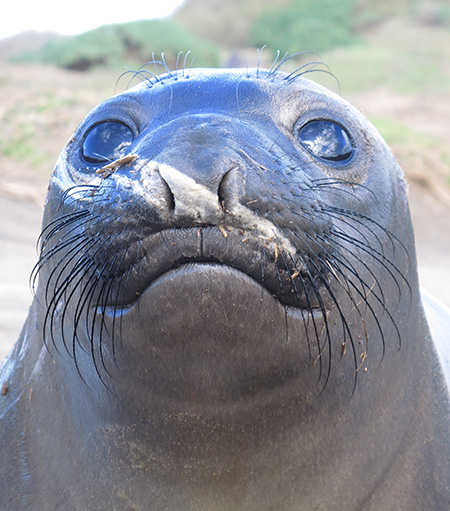The deep ocean is a dark place, yet deep-diving elephant seals can easily locate fish and squid in the darkness. A multinational research team has now shown how elephant seals use their sensitive whiskers to detect motion in the water and track down prey.
To conduct the study, published June 13 in the Proceedings of the National Academy of Sciences, researchers at UC Santa Cruz and the National Institute of Polar Research (NIPR) in Japan deployed miniature video cameras attached to the cheeks of female elephant seals, along with other innovative technologies for tracking the seals’ behavior in the wild.
Other researchers have used experimental studies of seals in controlled settings to show, for example, that blindfolded harbor seals can use their whiskers to detect slight motions in the water and follow the hydrodynamic trails behind moving objects. Until now, however, there was no record of how seals actually use their whiskers in their natural environment.
The new study showed that elephant seals perform rhythmic whisker movements—protracting and retracting their whiskers—when they are searching for prey at depth. At the surface and at the start of dives, the seals kept their whiskers in a relaxed position, but once they reached depths where they typically forage for small fish and squid, they extended their whiskers and began the whisking motion, which is similar to the way rodents and other terrestrial mammals use whiskers to explore their environments.
Some of the prey in the deep ocean are bioluminescent, and elephant seals have eyes that are sensitive to dim light at the wavelengths of bioluminescence. But the researchers detected bioluminescence in only 20% of the feeding events recorded in the study.
“We found that even when they eat bioluminescent prey, they also use their whiskers to chase it, so we conclude that whisker sensing is the primary sensory hunting strategy of elephant seals,” said first author Taiki Adachi, a researcher at NIPR and currently a project scientist in the Beltran Lab at UC Santa Cruz.
“Other species that feed at these depths, like beaked whales, use active biosonar to locate prey. This is the elephant seal solution to foraging in darkness, since they don’t have biosonar,” said UC Santa Cruz researcher and coauthor Patrick Robinson.
Robinson manages the Año Nuevo Reserve where UCSC scientists have been studying elephant seals since the 1960s. Part of the UC Natural Reserve System, Año Nuevo is the site of a large elephant seal breeding colony. Elephant seal researchers at UC Santa Cruz have been collaborating with Japanese scientists at NIPR since the 1980s.
Coauthor and principal investigator Daniel Costa, professor of ecology and evolutionary biology and director of the UCSC Institute of Marine Sciences, has been a pioneer in the development and use of electronic tags to track the movements and behavior of marine mammals. NIPR scientists have developed many innovative sensors and data loggers for use in these studies, including the miniature video cameras used to record whisker movements and an accelerometer attached to the seal’s jaw that indicates when it is feeding.
“This study is part of an amazing long-term collaboration between UCSC and the National Institute of Polar Research, starting in the late 1980s with Burney Le Boeuf and Yasu Naito, and continuing with other investigators like myself, Roxanne Beltran, Akinori Takahashi, and now Taiki Adachi,” Costa said. "They have been bringing state-of-the-art instrumentation that has truly enriched our elephant seal research program.”
The technology enabled researchers to observe elephant seals foraging in the extreme environment of the deep, dark ocean. The video logger was equipped with an LED red/infrared-light flash which was not visible to the seal, but allowed the researchers to observe noninvasively how the seals use their whiskers as they approach their prey. The cameras showed that the seals captured moving prey by sensing the water movement.
“The jaw loggers measure feeding events, so we could see what they were doing with their whiskers in relation to feeding, and it matches up well,” Robinson said.
Unlike humans, most mammals have mobile facial whiskers (called “vibrissae”). Elephant seals have the highest number of nerve fibers per whisker of any mammal. The deep ocean is relatively “quiet” in terms of hydrodynamic vibrations, and elephant seals may even be able to detect the breathing currents of an immobile fish as it moves water over its gills, the authors said.
“Our findings solve a decades-long mystery about how deep-diving seals locate their prey without the biosonar used by whales, revealing another mammalian adaptation to complete darkness,” Adachi said.
This research complements earlier whisker studies conducted on mammals in captive conditions, and it propels forward the field of sensory ecology of foraging. “The next step is conducting comparative field studies on other mammals to better understand how whisker-sensing shapes natural behavior in each mammalian species under different environments,” said Adachi.
In addition to Adachi, Robinson, and Costa, the coauthors of the paper include Yasuhiko Naito and Akinori Takahashi at NIPR; Luis A. Hückstädt and Rachel Holser at UC Santa Cruz; and Wataru Iwasaki at the University of Tokyo.
The research was funded by grants from the Japan Society for the Promotion of Science, the U.S. Office of Naval Research, and the E&P Sound and Marine Life Joint Industry Project of the International Association of Oil and Gas Producers.




